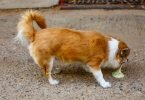Dogs are regarded as the best friend of man because of their unique behavioral features, sensory abilities, and physical capabilities. In this 21st century, the adaption of dogs as part of the family is on the increase, and this has brought about the formation of various policies that help to ensure the wellbeing of these unique mammals. Normal and regular stooling is seen as evidence of good health in dogs. But if there is blood in the stool, it signifies health danger, which, if not properly treated, could lead to the death of this precious animal. So we may be asking, what does it mean to see blood in a dog stool? What are the causes of blood in dog stool? How can it be prevented? Do we have home remedies that could be used for treatment?
Blood in dog stool, what does it mean?
Blood in dog stool is not necessarily an emergency. It shouldn’t be a cause of an alarm but should be a thing of concern, as it can serve as an indicator of an underlying issue. Blood in dog stool signifies two conditions; hematochezia and melena. Hematochezia is bright red blood that mixes with dog stool, as a result of an abnormality in the lower digestive tract or colon. While melena is a jelly-like stool that is dark and tricky, which indicates a problem in the upper digestive tract.
Red blood in dog stool: meaning, symptoms, and causes
As stated earlier, red blood in dog stool signifies Hematocheria, which is an indicator of an abnormality in the lower tract. Hematochezia is the passage of fresh blood, which could be seen visibly in the dog stool.
Symptoms
The primary symptom of hematochezia in dogs is the appearance of fresh red blood in the stool. Other symptoms include difficulty in defecation, including strain during defecation and also constant defecation.
Causes
Irritation arising from a change in diet
Most English dogs are trained in a particular diet, so when accidentally, if they are given another diet, a bit different than the ones they are used to, it could lead to an Irritation in the lower abdomen that could cause bleeding.
Irritation from swallowing non-digestible materials
Non – digestible materials like bone shards, plastic, and rubber, when swallowed, could cause indigestion in the dogs. So when your dogs are out there playing with the kids and their toys, an eye should be kept on them. Most of the time, kids infuse these hard objects into the dogs while playing because of having no knowledge of the consequence.
Dietary intolerance or allergies
Some species of dogs, especially the English dogs, can be allergic to certain diets. Before you even consider buying a dog, ensure you carry out proper research on the right diet appropriate for the dog to feed on.
Bacterial, viral, or parasitic infections
Hematochezia can be caused by an infection, which is either caused by bacteria, viruses, or parasites. Please make sure the places that your dog sleep in are dirt-free, so they don’t attract any form of parasites, virus or bacteria.
Blood in jelly-like stool: meaning, symptoms, and causes
Blood in the jelly-like stool is called melena, which normally results in a dark stool containing blood, which indicates an abnormality in the upper digestive tract. Melena represents a severe, life-threatening illness, which should not be ignored. It is a worse case than hematochezia.
Symptoms
- Dark, almost black stools
- Weight loss of the animal
- Poor appetite
- Vomiting
- Diarrhea
- Excessive urinating
Causes
Melena can be caused by the introduction of foreign bodies into the stomach of the dog, which could be in the form of non – digestible substances or garbage food.
Melena can also be caused by the infusion of certain toxic substances and drugs into the dog, which could cause Irritation leading to an abnormality in the upper tract or colon. Household drugs should be kept out of the reach of these precious animals.
Causes of blood in dog stool and diarrhea
The saying “prevention is better than cure” can’t be effective without knowing the cause. Therefore the general causes of blood in dog stool and Diarrhea are listed below:
Rickettsial
It is a tick-transmitted disease that could affect the digestive gland of the dog, leading to the growth of abnormality, which could cause diarrhea and blood in the stool. Effective vaccination is a great preventive measure for this. Ensure your dog gets the right vaccination at the right time.
Eating garbage and spoiled food
Garbage and spoiled food, when eaten, could lead to bacterial and fungal infection. Most spoilt foods contain harmful parasites, worms, bacteria, and fungi. When dogs feed on them, these harmful micro-organisms will be deposited into the dog’s stomach. This might lead to infection and inflammation, resulting in Diarrhea and blood in the stool.
Injecting non-food items
Non-food items like plastics, little balls can cause indigestion in the dog’s stomach. They can lead to the growth of abnormalities, if not properly checked on time and removed.
Drugs and toxins
Toxins like acid, alkali, can be dangerous to a dog’s health. Avoiding exposing dogs to an environment contaminated by these harmful substances. Apart from the fact that it does attack the dog’s respiratory organs, it greatly disrupts the digestive process.
Changes in diet
Avoid changing the dog’s diet. Cling to a particular diet, and ensure you stick to it.
Viral, bacterial, fungi, and parasitic infections
Keep dogs in a clean, friendly environment, free from dirt, and exposure to garbage. Ensure you keep your dog’s sleeping environment, constantly cleaned and disinfected.
Pancreatitis
The inflammation of the pancreas can be caused by the infusion of toxic drugs and harmful parasites and bacterial, which acts on the digestive gland.
Ensuring effective cleanliness of the dog environment could go a long way in preventing blood in the stool and Diarrhea.
Home Remedies in curing blood in the stool
We have some home remedies up our sleeves. These home remedies have been proven to cure and also prevent the disease from getting worse.

Ensure effective hydration
When your dog is faced with Diarrhea and blood in the stool, it should be given enough water to flush out the substances in its stomach. Make sure you do this regularly to keep the dog in check.
Fast
It is an effective method of curing blood in the stool and Diarrhea, especially if a food-related substance causes it. If you have adult dogs, let them fast for twenty-four (24) hours. You can allow your puppies to fast not more than twelve (12) hours. Let your dog observe effective hydration during the fast.
Yogurt
Yogurt mixed with some cottage cheese can be administered to the dog. You can do this in addition to a bland diet, and this takes us to the next point.
Bland diet
A bland diet includes chicken broth (that is, white meat chicken with no bones or skin). You can give this to your dog. It helps ease the pain and stop the bloody stool. White rice can also be given. Instead of white rice, sweet potato or pumpkin can be used. The chicken you are to use in the chicken broth should be low in sodium, and it should be diluted. It is strongly advised you give this in addition to water. Ensure that fatty and greasy food are avoided during this period.
Pedialyte
It could come in a powdery or liquid form. Pedialyte helps in replenishing nutrients in the animal body and aid the formation of good bacteria. You can add it to your dog’s food and mix. This medicine can be gotten from the pharmacy or laboratory.
Conclusion
Blood in the stool is a thing of concern, but not alarming. These above remedies, when mastered and implemented, could go a long way in saving the life of your precious pet animal, and it could also serve as first aid, as one waits for the veterinary doctor.






